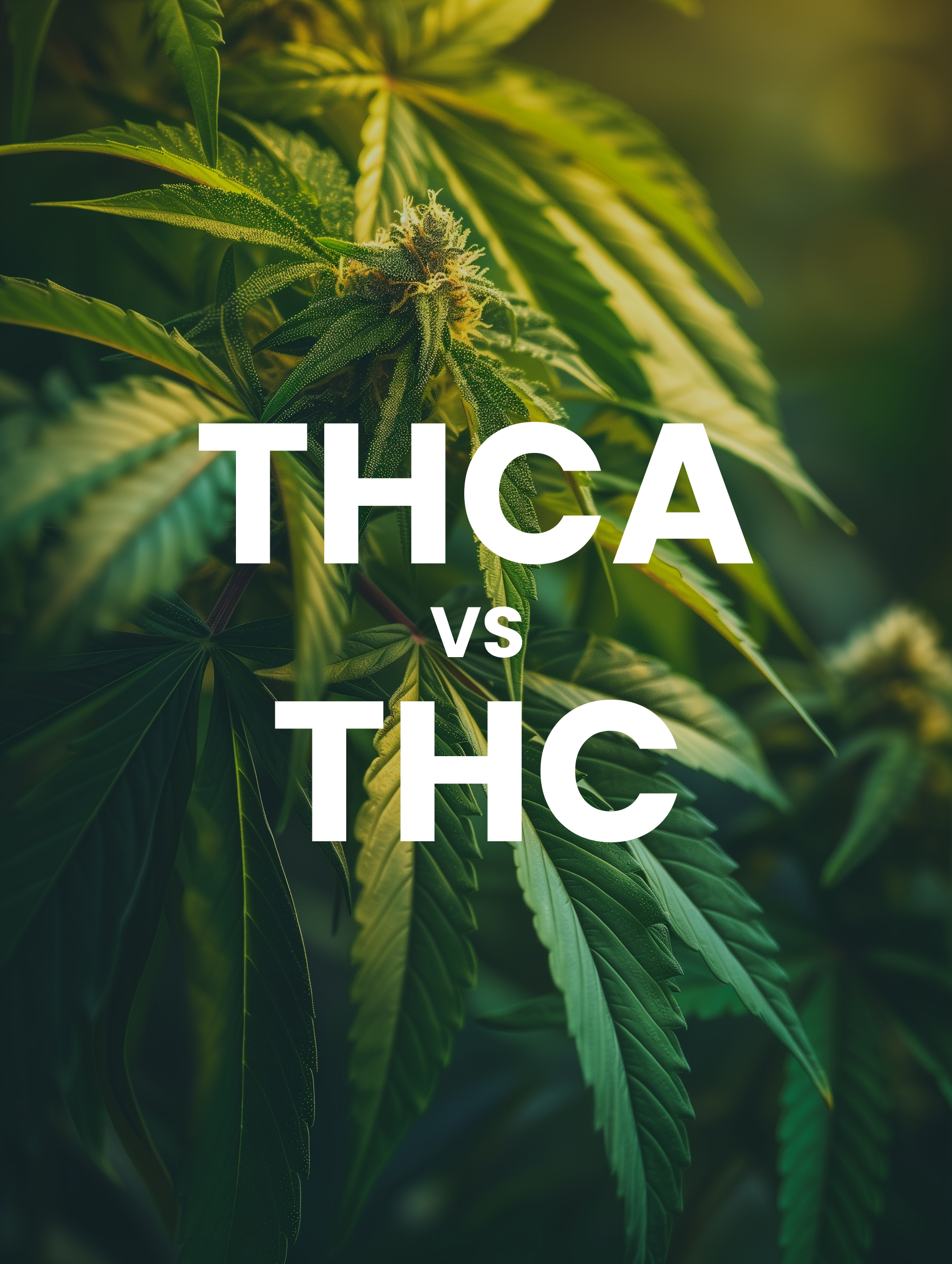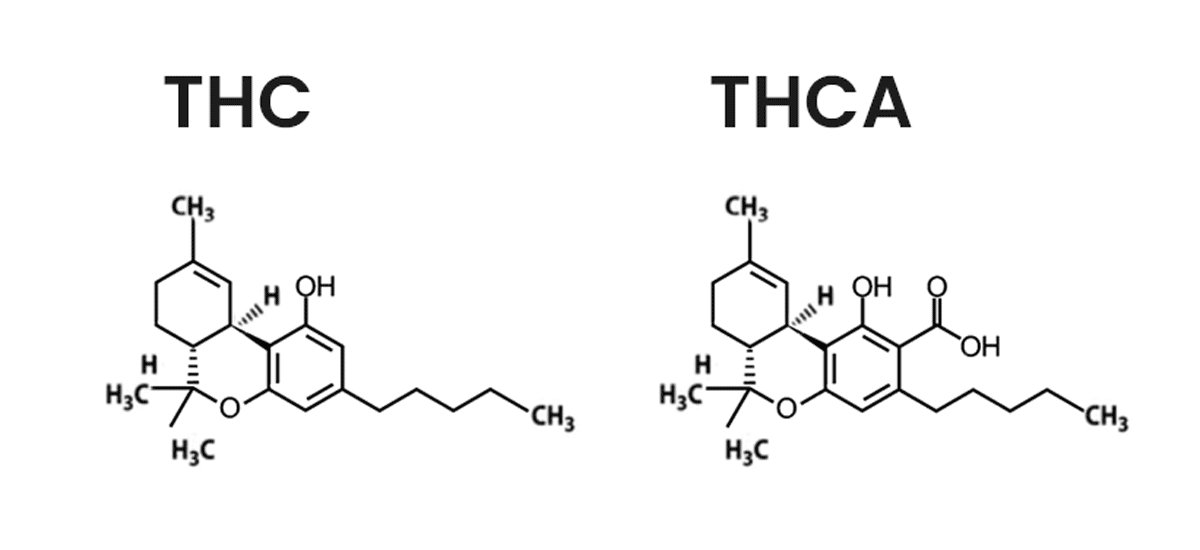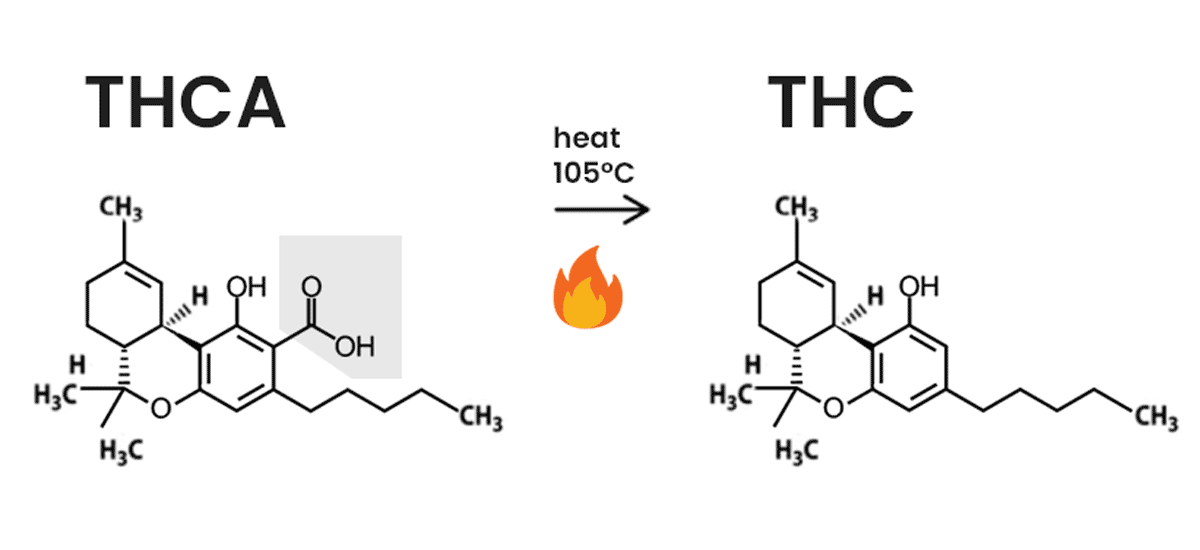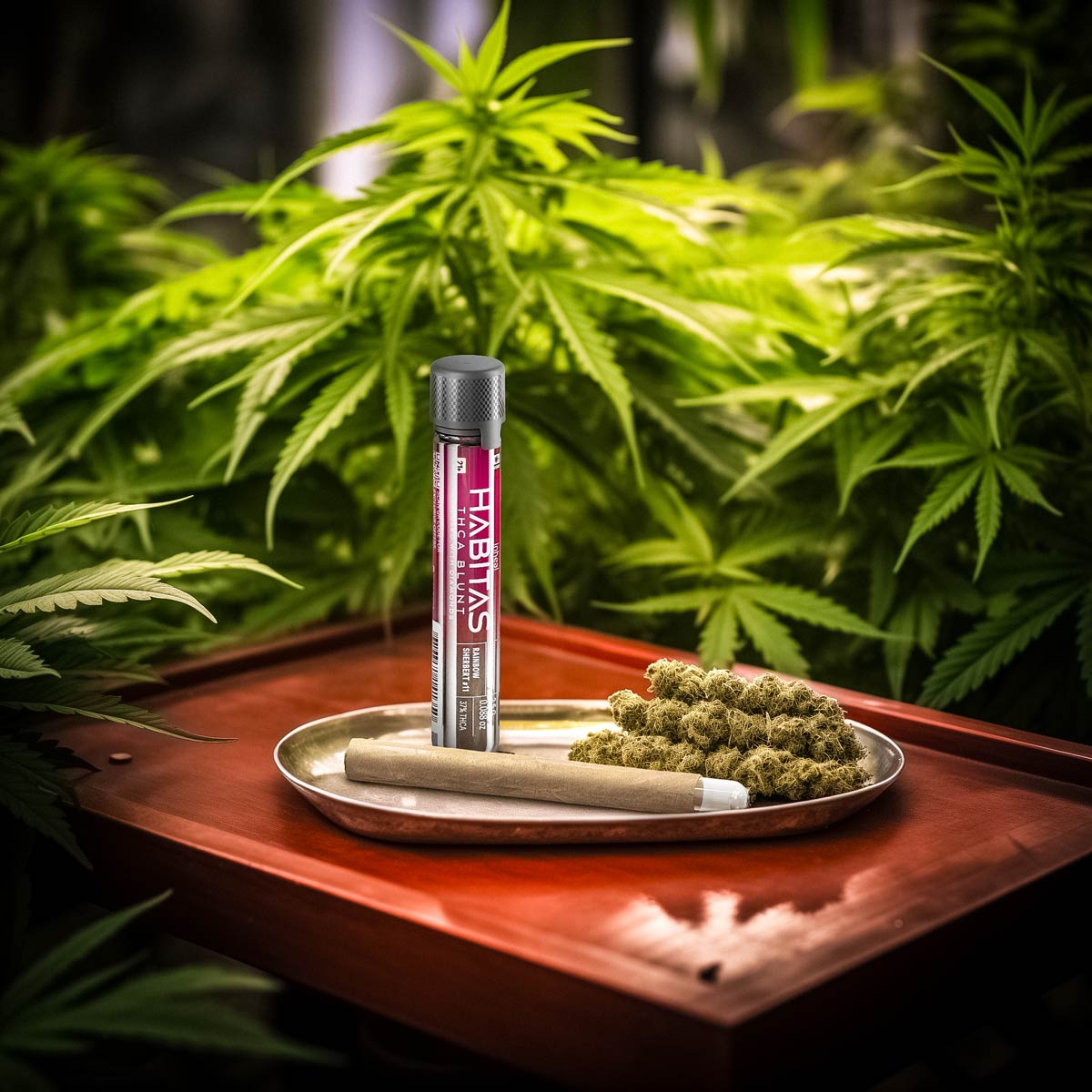Please confirm that you are 21 years of age or older
Please confirm that you are 21 years of age or older
By entering you accept our terms and conditions and our privacy policy.
There’s a valley in our minds, nestled between the mighty mountains of want and wonder. We wander there sometimes, our feet made swift by curiosity, gaze fixed on the horizon beyond. Such is the call of the unknown. Like a siren’s song, it beckons, tugging at our very core until we surrender thought and limb to the quest.
So it is with THCA vs THC, these storied cannabinoids we hold with such reverence. We speak of them in hushed tones, filled with promise and mystery alike. They tease of a great revealing, if we but wander deeper into cannabis’ embryonic embrace.
What is the difference between THC and THCA? Let us travel now through lush fields of discovery, two chemical compositions our steady companions.
In short, THCA is a non-intoxicating compound in raw cannabis that converts to psychoactive THC when heated, offering different potential medical and recreational benefits based on personal preference and legality.
What inspired insights have we gleaned about the chemical compounds while comparing THCA vs THC?


Before we contrast THCA and its famed cousin THC, we must first sweep broadly the vibrant landscape of cannabinoids from whence they came. Picture the cannabis plant in your mind’s eye, resplendent in emerald hues, its fan leaves outstretched to the sun like a great green goddess. Upon these verdant surfaces dwell the trichomes, microscopic factories producing the many chemical compounds we prize.
Chief among them are the cannabinoids, a family vast and varied. THC and THCA belong to this storied tribe, playing their own small part in cannabis’ great fugue.

Imagine again our proud cannabis matriarch, this time heavy with flower ready for harvest. A closer look reveals something curious – no THC graces her buds! Instead, she produces tetrahydrocannabinolic acid, or THCA, the precursor essence from whence THC is born.
THCA differs from its fabled offspring in both effects and form. Its bulky carboxyl group prevents much interaction with our internal endocannabinoid system. This renders THCA non-psychoactive, devoid of THC’s storied mind-altering effects. THCA’s molecular purpose lies elsewhere, its primary role being a parent molecule ready to nourish creation.
Without inducing euphoria or changes in perception, THCA may provide other gifts. Potential THCA benefits currently under investigation include:
Yet even in this primordial state, promise dwells. Researchers now believe THCA may combat inflammation, quell nausea, spur appetite, and shield neurons from harm. Such gifts should not be overlooked simply for lack of inebriation. Our cannabis queen’s generosity extends beyond the veil of intoxication.
Luckily, the apple falls not far. When heat and time act upon raw cannabis, THCA births a new incarnation – the legendary THC, or tetrahydrocannabinol. Under warmth’s alchemy, the THCA molecule loses its carboxyl appendage, gaining potent new powers.
Unbound, THC slips effortlessly into our endocannabinoid receptors, binding with CB1 especially. This biological “handshake” triggers euphoric engagement with our central nervous system. Effects cascade, both mental and physical, from altered perceptions to pain relief to improved sleep. THC’s benefits may be myriad, but they find their origin in this simple molecular reaction.
Beyond getting people high, possible therapeutic THC benefits include:
Of course, much remains in flux legally. While THC garners both acclaim and notoriety for its intoxicating effects, its presence still prohibits cannabis in many arenas. Tensions will linger until society accepts cannabis’ full spectrum of gifts. In the meantime, we must push for understanding, not opposition, around this humble plant.

Though siblings birthed of the same rich botanical origins, THCA and THC ultimately display more divergence than similarity. Let us illuminate several core distinctions.
In chemical structure, the extra carboxyl group of THCA creates a bulky impediment to direct receptor binding. By losing this group when decarboxylate processes to THC, cannabis unlocks its intoxicating potential.
Relatedly, physiological effect presents the starkest contrast. THCA’s molecular inhibition translates to negligible engagement with our endocannabinoid system. No euphoric “high” accompanies its consumption. However, THC elicits pronounced interaction with CB receptors, especially CB1 in the nervous system. This grants its psychoactive potency.
Legally, the line also diverges. Most jurisdictions, bound to tradition, continue prohibition against all forms of THC, even benign THCA. However, as reform creeps ahead, legislation may one day acknowledge the divisions between an inebriant and its subdued precursor. Until then, skepticism remains THCA’s faithful ward.
Of course, commonalities yet persist. Both share potential therapeutic benefits, from anti-inflammatory to neuroprotective properties. And they originate from the same whole plant source, reminding us nature cannot be bottled and bound easily.
Once freed by heat’s alchemy, THC nestles easily into tinctures, topicals, edibles and smokeables. But for THCA, raw is law. Gentle handling preserves its unbound integrity.
Juicing – Juicing raw cannabis buds or leaves to make a smoothie or juice preserves THCA content. This allows you to ingest THCA without causing a high.
Smoking – Any form of heating, including smoking joints, bowls or dabs, decarboxylates THCA into THC as it enters your lungs. Expect a faster high onset than other methods. For example, from diamond-infused blunts.
Vaporizing – Like smoking vaping concentrates or vape oils make THCA converted to THC for swift absorption into the bloodstream. Vaporizing prevents combustion toxins.
Edibles – Heating cannabis during the cooking process decarboxylates THCA, so edibles contain THC rather than THCA. Expect the effects in 30-90 minutes.
Tinctures – Sublingual cannabis tinctures also provide access to THCA, which your body absorbs directly into the bloodstream under the tongue.
Topicals – Applied externally rather than ingested, THC and THCA topicals offer potential localized benefits without systemic effects.
Dosing landmarks differ as well. Acute intoxication limits THC’s upward flight, while THCA’s chosen path may demand higher quantities for full effect. Start low with each, calibrating carefully, and document your journey well. Inner wisdom must remain the primary guide.
Learn more on topic Is THCA visible on drug test?
When selecting a path forward, recall that cannabis gifts us choice, not mandate. Seek the molecule that nourishes rather than numbs your spirit. Be true to your healing.
If recreational or medical needs demand THC sensual heights, embrace the soaring potential, but temper with wisdom. Clear intention and moderation guard against overindulgence. Balance worldly pleasure with higher callings.
For those desiring subtlety, THCA gentle family of effects may prove more appropriate. Tend your health, serve your community, and bring forth your highest self. Thrive through noble deeds, spreading compassion.
Of course, many will wish to explore each in good time, following curiosity’s ebb and flow. Phases come and go. Stay open and mindful, letting inner truth refine your path.
Regardless the direction chosen, let it arise from personal knowledge paired with common sense. Never accept another’s path blindly. Our bonds with this plant will serve us best when forged through direct experience.

With cannabis products becoming more widely accepted and used for wellness, understanding the differences between components like THCA vs THC holds great significance for consumers seeking the best outcomes.
While research continues to uncover their promising medical potentials, individuals must educate themselves on how THCA and THC interact in the body and align with personal health goals and lifestyles.
Factoring in considerations around benefits, legal status, drug testing, and access ultimately empowers smart, intentional use. Just remember – start low, go slow, and enable informed discussions with your health providers when incorporating cannabis into treatment options.

A connoisseur of cannabis creativity and true contemplation with more than 20 years of experience, Chris extracts deep thoughts from getting lightly baked and shares his wandering mind. He blends cuisine and cannabis culture into nutritious, delicious recipes and insights for other hemp lovers.
The statements on this blog are not intended to diagnose, cure, treat or prevent any disease. FDA has not evaluated statements contained within the blog. Information on this website or in any materials or communications from Inheal is for educational/informational purposes only and is not a substitute for medical advice, diagnosis, or treatment. Please consult your healthcare provider before making any healthcare decisions, correct dosage or for guidance about a specific medical condition.

Disclaimer: We work diligently to make sure all product information on our website is correct. The actual product packaging and materials may contain different information than what’s listed on our website. Please make sure to read labels, warnings, and directions on the packaging itself before using or consuming a product. If you have any questions about a product, please contact customer service. Content on this site is for reference purposes only and isn’t intended to replace advice from a physician, pharmacist, or other licensed health-care professional.
Inheal products are made with uniquely sourced, naturally occurring cannabinoids from hemp which is grown in the US.
Statements on this site related to inheal products have not been evaluated by the FDA. This website is not intended to diagnose, treat, cure or prevent any disease. Results from using these products may vary.
In December 2018, the 2018 Farm Bill became law by removing hemp from the federal list of controlled substances and classifying it as an agricultural commodity. All inheal products are meant for adults only.
California Prop 65 Warning
This product contains a chemical (delta-9 tetrahydrocannabinol) known to the state of California to cause birth defects or other reproductive harm. For more information, go to www.p65warnings.ca.gov